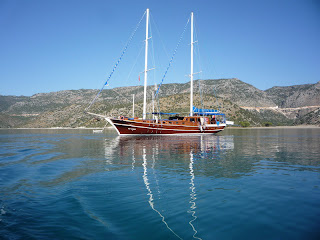I think you’d be hard pressed to find
another country that has such genuine love and appreciation of another human
than the Turks do for Mustafa Kemel, or Ataturk
(meaning Father Turk) as he is more commonly known. Reading through the history
of his life and role in shaping modern Turkey it’s easy to understand the
source of this admiration. For the Turks there’s no question as to who is the
Daddy and the only other country I can think that has a similar relationship is
the Vietnamese reverence for Ho Chi Minh.
Today the physical actualization of this
admiration is borne out through, at minimum; an Ataturk statue in every town,
his name adorning every imaginable piece of infrastructure and his benevolent
gaze staring down from behind the counter of any commercial enterprise you may
come across.
 |
| Kayakoy |
While we were on the coast in Fethiye to commence
our four day gulet cruise to Olympos we had enough time to visit the eerily deserted
ghost town of Kayakoy, a consequence of an Ataturk policy in the 1920s to avoid
future sectarian conflicts and ensure a Turkish republic solely for Turks
through population exchanges.
 It’s a short minibus ride from Fethiye to
Kayakoy, but for the unsuspecting, such as us, the ride passes through the
ultimate chav dream resort of
Oludeniz, where a full English roast is available everyday of the year and neon
lit establishments, such as the bemusingly named 'Grand Boozey', do a thriving
trade. Like most Turkish sites once
you’ve paid a nominal entrance fee you’re free to climb on, over, up and down unhindered
and so we spent an enjoyable afternoon clambering over the former Greek speaking town whose population was forced to depart for Greece under the population exchange program.
It’s a short minibus ride from Fethiye to
Kayakoy, but for the unsuspecting, such as us, the ride passes through the
ultimate chav dream resort of
Oludeniz, where a full English roast is available everyday of the year and neon
lit establishments, such as the bemusingly named 'Grand Boozey', do a thriving
trade. Like most Turkish sites once
you’ve paid a nominal entrance fee you’re free to climb on, over, up and down unhindered
and so we spent an enjoyable afternoon clambering over the former Greek speaking town whose population was forced to depart for Greece under the population exchange program.
Scouring the list of available tourist
activities in Turkey I’d quickly singled out the desire to spend several days
puttering along the Turkish coast line in a hand made traditional wooden
Turkish ‘gulet’ vessel. It’s a
popular activity with numerous operators and having singled it out I was also
responsible for choosing one. Fortunately I was saved this task through the
fruits of my side project of chatting with elderly American men in unusual
locations around the globe. A conversation with a retired professor from the
University of Nebraska following a swim in the hotel pool in Selcuk revealed
he’d done his research and chosen V-Go. On this basis we found ourselves with
thirteen others assembled outside the V-Go office in Fethiye ready to board our
cruise one warm clear morning.
 |
| The mighty Mavi Boncuk |
Any group activity with a bunch of
strangers, and especially one in an effectively confined space for four days,
there’s concern you’ll be stuck for days on end with a bunch of nuff nuffs. As we motored out of Fethiye aboard the
‘Mavi Boncuk’, (replete with suitably benevolent Ataturk portrait) to our first
stop, the stunning beach at Butterfly Valley wedged between two mountains,
these fears were quickly allayed and over the course of the next four days I
was constantly surprised how well our group, consisting of mainly Americans and
Australians, gelled.
Part of this could have also been down to
the clear crystal waters, the feeling timeless sunny hot days brings and a sea so
calm that most of the time it resembled a deep blue liquid chrome. Combined with the realisation that
there was nowt to do except swim, converse, laze on the deck, wonder if it was
too early for a beer and enjoy the next sumptuous meal prepared by the crew,
it’d take a miserable soul indeed not to gell with your fellow travellers. Even Tony managed a smile, well, more a grimace, but it's a start.
The following morning our gulet slowly made
its way along the coast towards the Kekova region where we’d spend the next few
days, overnighting initially at the beautiful secluded town of Kas, set in a
bay at the base of a coastal mountain range, and the next at another still
calm bay. During the day we’d drop
anchor and snorkel, or, as in case of the small community of Simena, part of a
historical city sunken into the sea by an earthquake, be offered the chance to
go ashore.
 |
| Butterfly Valley |
The water clarity visibly highlighted however
the extent of overfishing along the course of our voyage. While in 2006 WWF
convinced the local authorities to declare most of our route a marine park, the
sea felt largely bereft of marine life, with all but the tiddliest of tiddlers absent
at depths up to 10m. It was startling and made me question a number of times
the source of the fish in the numerous seafood restaurants dotted along the
coast.
With my initial reservations completely
unfounded it was in the end all too soon that we were saying goodbyes at the
port of Demre and back into the swing of bus travel for our next destinations,
and like most we were headed for the Olympos region.




No comments:
Post a Comment